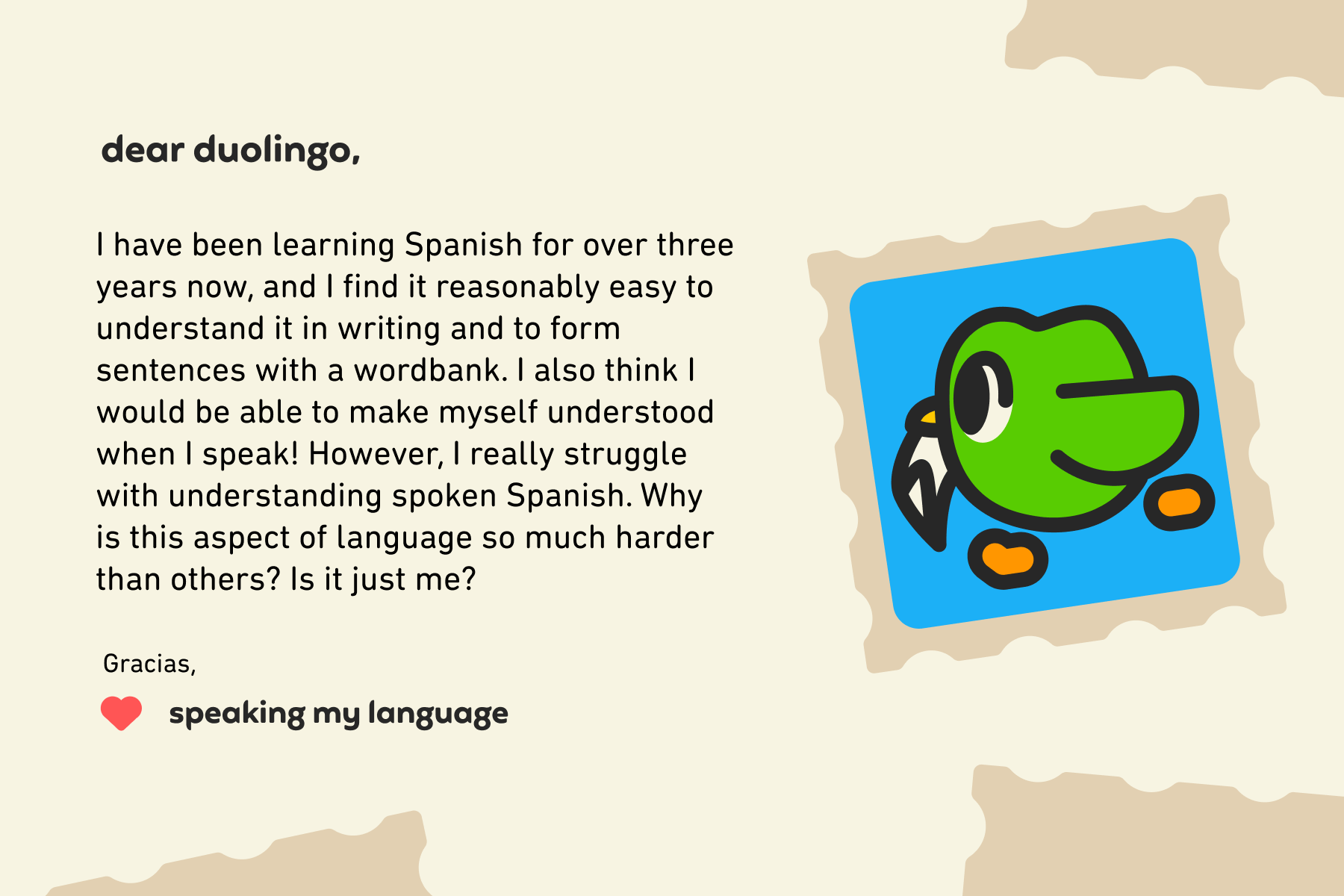Welcome to another week of Dear Duolingo, an advice column just for language learners. Catch up on past installments here.
Hi, everyone! This week on Dear Duolingo, we’ll be answering a question about an experience that nearly all learners report having. It’s especially common for new learners, but as this week’s reader points out, it’s true for intermediate and even advanced learners, too!
This week’s question:

The first thing to know is that this is a really common experience, and no, it’s not just you! It’s not because of your age, or your study habits, or the lessons you’re doing on Duolingo. It has everything to do with your brain! 🧠
Listening and understanding present unique challenges to learners because there’s typically time pressure to keep up with the speaker in the moment, plus you’ll probably have to formulate a response! The situation is the same for learners studying signed languages, like American Sign Language, who have to follow many hand shapes, movements, and facial expressions to keep up with the conversation. To include both signed and spoken languages in our discussion here, I’m going to use “expressive” language to mean speech and signed language. It turns out that the reasons they’re difficult for learners are the same!
Expressive language doesn’t have spaces.
One of the biggest challenges about understanding expressive language—for adult learners and for babies, too—is that expressive language doesn’t have spaces. In writing, many languages use spaces between words to delineate where one stops and the next begins, and beginner learners look for those pauses… but they’re just not there!
Instead, what we get is something like thisexamplesentencerepresentshowweperceiveexpressivelanguage. Well, actually, in spoken language it’s like this image below, without even the benefit of clear, distinct letters or sounds. Where are the word boundaries? Can you believe this is a sentence with 7 words?

In our own language, we solved this “problem” long ago, as infants, but as adult learners we become really reliant on reading and wanting to know (and practice) single words. So when we don’t find pauses in expressive language, it can be really disorienting. (No wonder babies sleep so much!) We can sometimes have the perception that new languages are produced so fast or people never take a breath—but it’s really just that we aren’t practiced enough at finding word boundaries!
Expressive language disappears quickly.
Another challenge to understanding expressive language is that after it’s produced, it’s typically gone forever! If you’re watching a movie or listening on YouTube, you can slow down the audio and repeat if necessary, but for in-person interactions, after a word is produced, its visual shape or acoustic waves literally disappear (well, dissipate) into thin air. We can’t see or listen at our preferred pace, and if we lag behind remembering the meaning of one word, we’re already behind catching up to each word produced after it.
Expressive language never repeats itself.
There’s another challenge with that quickly-disappearing expressive language: It’s never produced the same way twice. There are always slight variations every time you produce it, and even though we hardly notice it in our own language, learners have to learn to adapt to brand-new variations.
Let’s take an example from English. We think of the “ee” sound in seat (/i/ in the International Phonetic Alphabet) as a single sound, but it’s actually a whole range of “ee”-like sounds. Your tongue is never in exactly the same place, for exactly the same length of time, every time you say a word with “ee.” How you pronounce it also differs according to the person saying the sound, how quickly they are speaking, the sound occurring before the “ee,” the sound occurring after the “ee,” and even who they’re talking to!
That means the “ee” in seat is *slightly* different from the “ee” in meat, which is *slightly* different from seem, which is *slightly* different from seek, etc. And my pronunciation of those “ee” sounds is subtly different every time I say them. And it’s different when I’m talking to my mom vs. when I’m talking to my best friend. And so on and so on!
So how can learners know what counts as seat vs. sit vs. set if there aren’t even specific definitions of what counts as an “ee”?! 😬 We don’t notice how much adapting and adjusting our brain has to do in our own language, but in a new language, we have to re-learn those sound boundaries, for potentially dozens of new sounds.
Expressive language is unpredictable.
When you are speaking, you have a lot of control over what words you’re going to produce next, more or less. But when you’re interacting with someone else, you’re at their mercy! There are definitely patterns for what words go together and what you’re likely to encounter based on a given topic or conversation, but you don’t know for sure what vocabulary or grammar is coming next. (Much less whether it is words or grammar you have studied before!)
It takes years, and lots of conversations, to build up enough data in your brain for it to start making predictions about what you might hear or see next. These experiences and expectations (data!) help us process and understand our own language really quickly: Of the hundreds of thousands of words you might encounter, the data your brain has stored about sentence patterns helps you narrow down what could come next, even before the person has produced it!
Expressive language is a moving target.
Well, not just expressive language: All of language is a moving target! Languages are constantly changing, new words are being added and old ones are falling out of use (or acquiring new meanings!), dialects are evolving, and brand-new slang is introduced. (That’s why it’s not always even clear what counts as a single language!)
Because language is changing every day, it’s simply impossible for learners to keep up and know the most current trends and features of the language they’re studying. (And not just for learners—I definitely haven’t kept up with Gen Z slang in English! 👵🏼) Even in your own town or region, you probably notice differences between people of different ages, educational backgrounds, ethnicities, religions, and genders. No one talks quite like what you’re learning on Duolingo—and they definitely don’t talk like textbooks. (Actually, real people don’t even talk like in the movies, which is why there’s such a difference between how scripted and reality TV sound!)
When you study a language, what you’re doing is building a foundation for using language out in the world. You can never learn it all—and you probably don’t need to—but you can get the right tools so that you’re ready to communicate successfully and start adopting the language features of the people you’ll be communicating with the most!
Truer words have never been spoken!
Getting the hang of fluid, natural conversation in a new language requires more than knowing words, grammar, and pronunciation—your brain needs lots of data and practice! The best way to strengthen this skill is to keep at it, by using subtitles to support your comprehension, getting lots of practice listening (including listening to music!), and being brave and patient with yourself when chatting with people in person.
For more answers to your language and learning questions, get in touch with us by emailing dearduolingo@duolingo.com.
